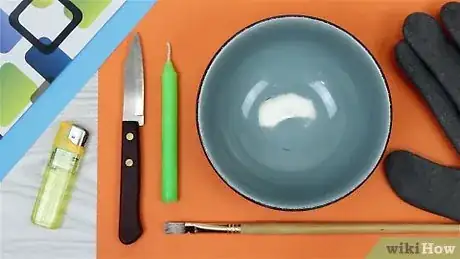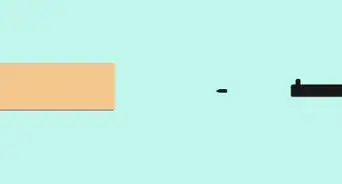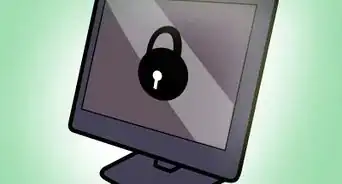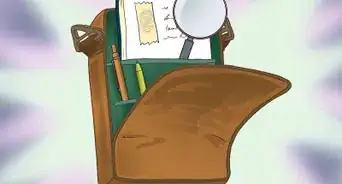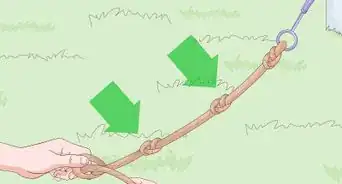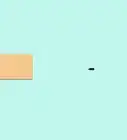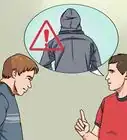This article was co-authored by wikiHow Staff. Our trained team of editors and researchers validate articles for accuracy and comprehensiveness. wikiHow's Content Management Team carefully monitors the work from our editorial staff to ensure that each article is backed by trusted research and meets our high quality standards.
There are 7 references cited in this article, which can be found at the bottom of the page.
The wikiHow Video Team also followed the article's instructions and verified that they work.
This article has been viewed 225,705 times.
Learn more...
No two people have matching fingerprints. Even identical twins have small differences in their fingerprints that make each one unique. When a person touches glass or other hard surfaces, they leave their prints behind. If you create your own fingerprint powder, you can easily lift these prints away from hard surfaces and examine them.
Steps
Mixing Fingerprint Powder
-
1Gather your materials. You will need corn starch, a measuring cup, a lighter or matches, a candle, a ceramic bowl, a knife or paintbrush, and a mixing bowl.[1] The mixing bowl can be glass, plastic, or ceramic. However, you can’t substitute the ceramic bowl for another kind of bowl. The process of making the fingerprint powder can crack glass and melt plastic.
- If you decide that making your own powder is too much trouble, you can buy it from science and hobby supply stores or online.
-
2Use the bowl and candle to create soot. First, use the lighter or the matches to light the candle. Next, hold the bottom of the ceramic bowl over the flame. The candle will burn a layer of soot onto the bottom of the bowl.[2] Move the bowl over the flame so that every part of the bottom touches the candle.
- Wear an oven mitt or use a dishtowel to protect your hand from the heat.
- Always be careful when working with an open flame. Children should have adult supervision.
Advertisement -
3Scrape off the soot into the mixing bowl. Hold the soot-covered bowl over the mixing bowl. Next, use a dull knife or a paintbrush to scrape the soot off of the ceramic bowl and into the mixing bowl. You will have about a teaspoon of soot. The more soot you have, the more fingerprint powder you will be able to make.
- Repeat these steps to make more soot as many times as you’d like.
- Scraping soot is very messy. If you want to avoid getting soot on your fingers, wear gloves. Similarly, cover your workspace with a towel to keep it clean.
-
4Mix the soot with corn starch. Use a measuring cup to evaluate how much soot you have gathered. Next, add an equal part of corn starch to the soot. Mix the two powders together well with a whisk.
- For example, if you collected a ¼ cup of soot, you would need to add a ¼ cup of corn starch.
-
5Store the powder in an airtight container. Place the fingerprint powder in a plastic food storage container with a lid. Alternatively, store your fingerprint powder in a plastic re-sealable bag. These containers are airtight and won’t allow any moisture into your powder.
- Keep the container on a shelf in a low-traffic area. Otherwise, someone may knock the powder over and create a sooty mess.
Lifting a Fingerprint
-
1Find a fingerprint. Search for household items that have been handled recently. Choose items with smooth surfaces. The smoother the surface, the easier it is to lift a fingerprint.[3] If you want to practice lifting fingerprints, you can make your own by touching a glass.
- Avoid trying to lift prints from soft, pliable surfaces. These surfaces require a special fingerprinting chemical.[4]
-
2Dust the powder over the print. Once you’ve located your fingerprint, sprinkle some of your fingerprinting powder over it in a thin layer. Next, carefully brush the powder over the fingerprint, covering it completely. Once the print is covered, gently brush the excess powder away. You will see a dark, clearly-defined fingerprint.
- Gently blow on the fingerprint to help remove excess powder.
-
3Use clear tape to lift the print.[5] Find some clear plastic tape. Measure out a small piece. Next, press the sticky side of the tape against the dust-covered fingerprint. Slowly pull the tape away to lift the print.
- Smooth out any wrinkles in the tape before lifting the print.
-
4Display the fingerprint. Press the sticky side of the fingerprinted tape onto a sheet of white paper or a white note card. The contrast of the dark fingerprint against the white paper will make the print easier to examine.
Identifying Fingerprints
-
1Catalogue your family. Ask each of your family members for a fingerprint. Tape the fingerprints on a notecard or a white sheet of paper. Record each family member’s name, birthday, and gender.
- You can catalogue one finger or all ten if you’d like. If you record all ten fingers, it will be easier to identify found prints.
-
2Classify your prints. Fingerprints come in three categories: arch, loop, and whirl. [6] These patterns are found in the lines from the fingerprints. An arch looks like a short bump. A loop looks like a long, thin arch. A whirl resembles a circle surrounded by smaller lines. These classifications are important when identifying fingerprints.
- Write the fingerprint classification for each family member on their fingerprint card.
- The different shapes can also lean left or right.[7] If so, indicate which direction the whirl, loop, or arch leans on the family members fingerprint card.
-
3Compare any found fingerprints. When you find fingerprints around the house, compare them to your catalogue. Look for matching classification and tilt. For example, if the fingerprint you found was a whirl that leaned to the left, you would look through your catalogue for a similarly identified print.
- Store successfully identified fingerprints on the back of their respective fingerprint card. This will make future identifications easier.
Community Q&A
-
QuestionCan I make graphite powder at home?
 Community AnswerYes. You can take some pencil lead and gently rub it on sandpaper and you'll have pretty fine quality powder.
Community AnswerYes. You can take some pencil lead and gently rub it on sandpaper and you'll have pretty fine quality powder. -
QuestionCan I use eyeshadow as fingerprint powder?
 Community AnswerEyeshadow would probably be too dark. Blush works well.
Community AnswerEyeshadow would probably be too dark. Blush works well. -
QuestionIs there a specific way to brush it on?
 Community AnswerSprinkle some powder on the fingerprint first and then brush it around to thoroughly coat the area. MAke sure to be gentle or you may scrub away the print!
Community AnswerSprinkle some powder on the fingerprint first and then brush it around to thoroughly coat the area. MAke sure to be gentle or you may scrub away the print!
Warnings
- Always be careful when working with open flames.⧼thumbs_response⧽
Things You’ll Need
- Corn starch
- Ceramic bowl
- Mixing bowl
- Candle
- Matches or a lighter
- A knife or a paintbrush
- Measuring cup
References
- ↑ https://www.youtube.com/watch?v=_iaBzjyczXU&feature=youtu.be&t=14
- ↑ https://www.youtube.com/watch?v=_iaBzjyczXU&feature=youtu.be&t=66
- ↑ https://www.youtube.com/watch?v=4bBCHByhpF4&feature=youtu.be&t=60
- ↑ http://www.cyberbee.com/whodunnit/dusting.html
- ↑ https://www.youtube.com/watch?v=4bBCHByhpF4&feature=youtu.be&t=77
- ↑ http://www.cyberbee.com/whodunnit/classify.html
- ↑ http://www.reachoutmichigan.org/funexperiments/agesubject/lessons/prints.html
About This Article
You can make your own fingerprint powder to easily lift people’s fingerprints off hard surfaces and examine them. To make your powder, you’ll need corn starch, a lighter or matches, a measuring cup, a candle, a ceramic bowl, a knife or paintbrush, and a mixing bowl. Light the candle and hold the bottom of the ceramic bowl over the flame until it burns a layer of soot onto the bottom of the bowl. Scrape the soot into a mixing bowl and mix it with corn starch. When you want to lift a print, dust the powder onto it, then press the sticky side of tape against the dust-covered fingerprint. Press the tape onto a sheet of white paper to make it easy to examine. To learn how to catalog your fingerprints, keep reading!
